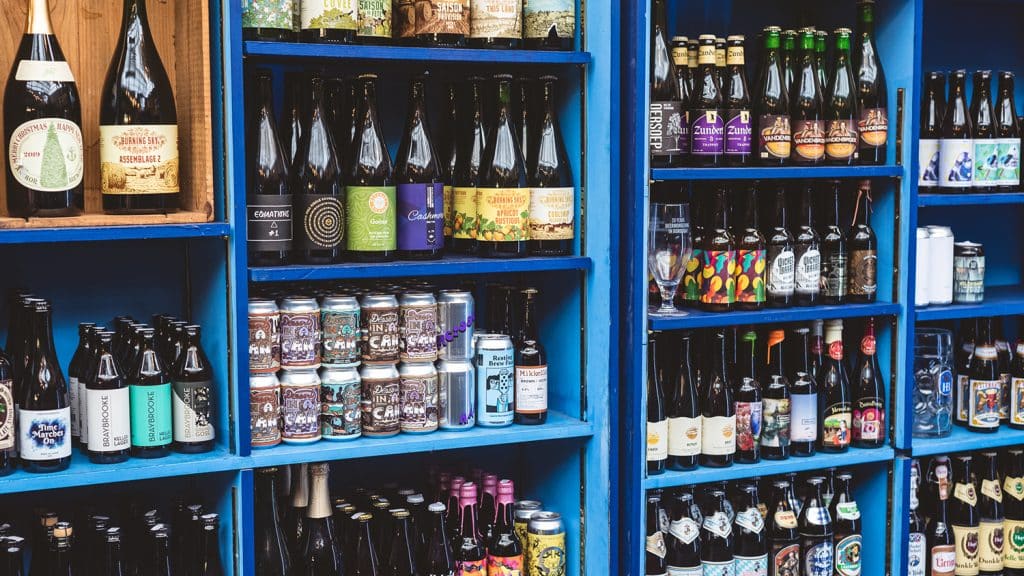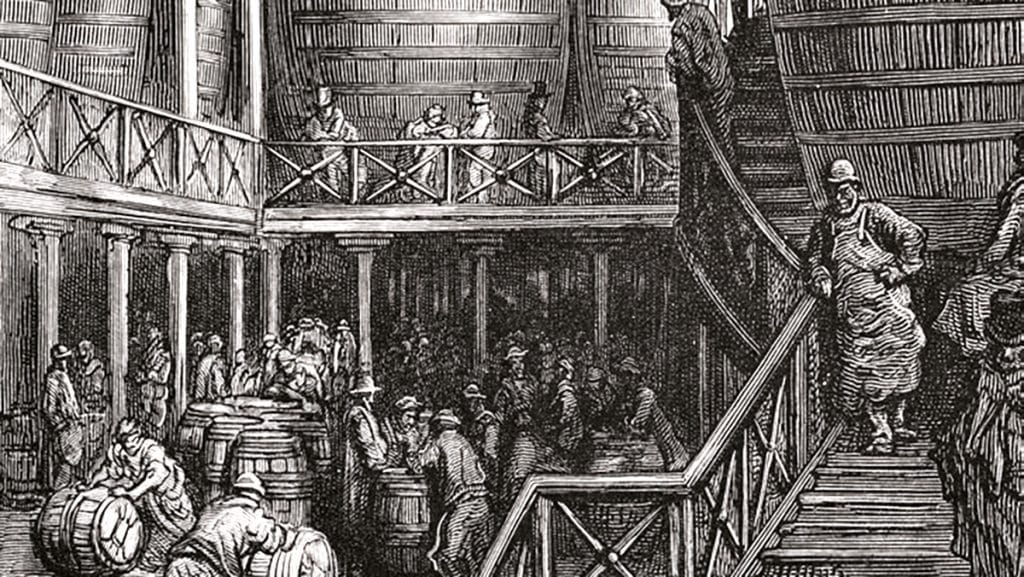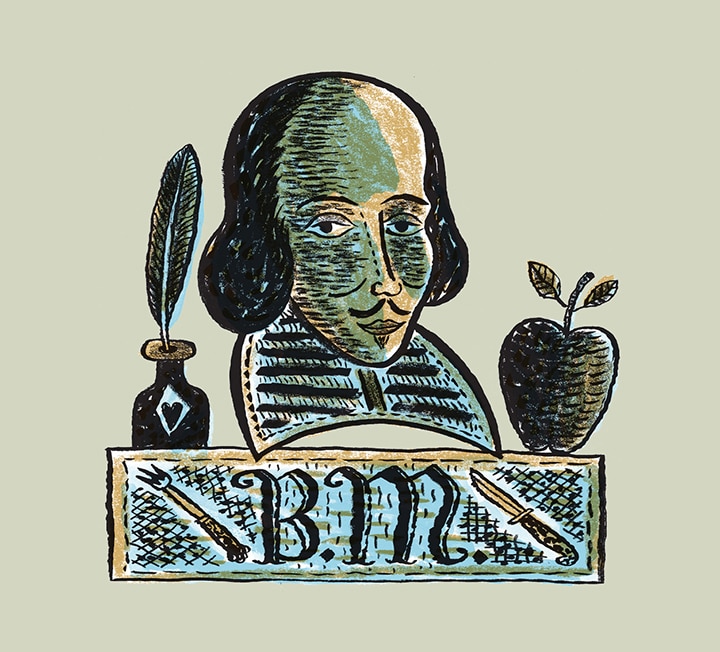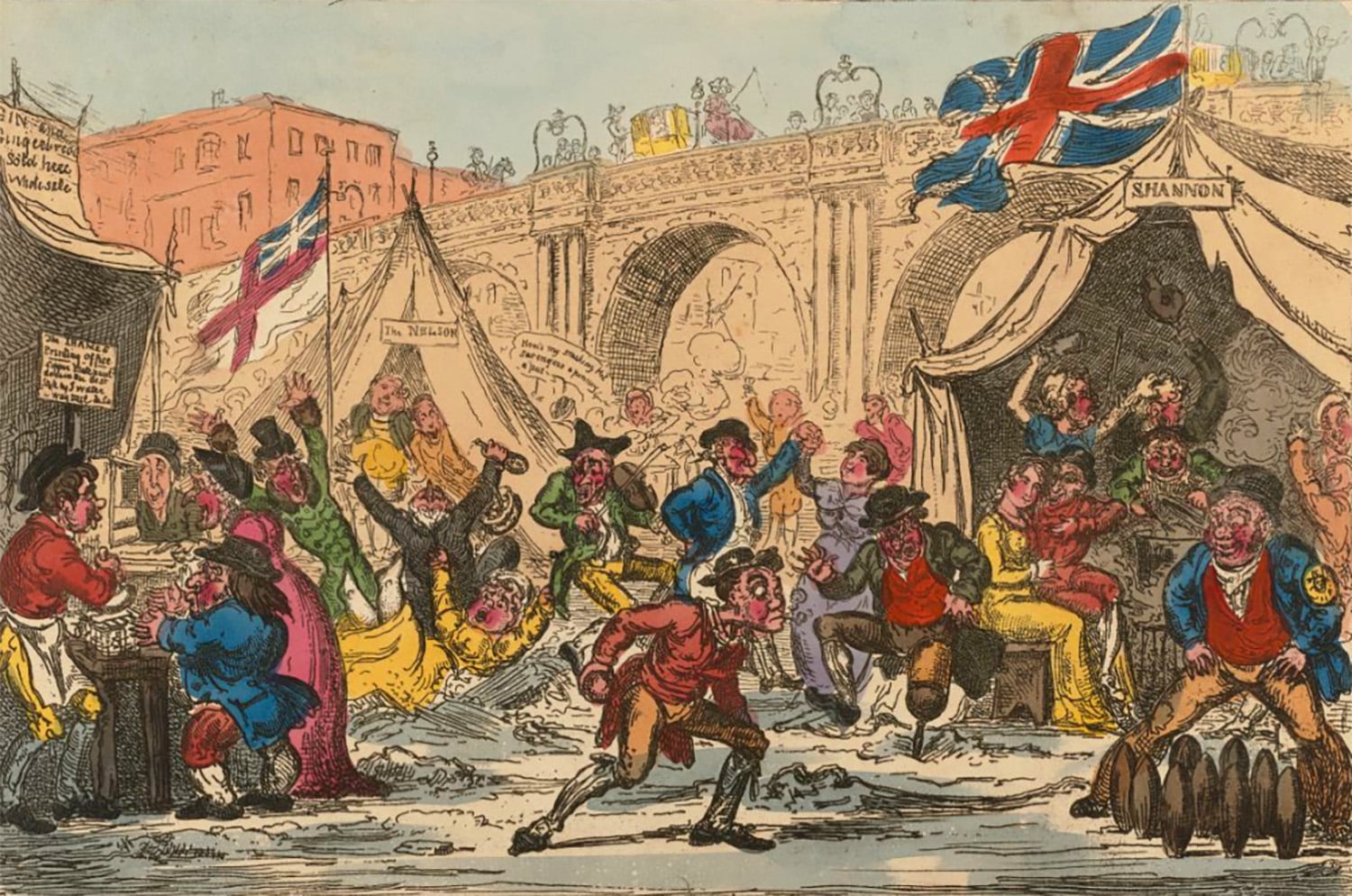Cask of thousands
Mark Riddaway takes a slightly groggy look back at a thousand years of Southwark ale


“WHERE THERE ARE MAJOR TRAVEL ROUTES LIKE LONDON BRIDGE, THERE WILL ALWAYS BE THIRSTY TRAVELLERS EAGER FOR A BEER”
Words: Mark Riddaway
In the prologue to his boisterous Canterbury Tale of adultery, mistaken identity and flatulence, Chaucer’s well-oiled miller asks his audience for their indulgence: “If that I misspeke or say / Wite it the ale of Southwark, I you pray.” Or, in other words: if I can’t talk properly, blame the Borough beer.
Southwark has been closely associated with beer for the entire thousand-year span of Borough Market’s history – with boozing and food shopping having thrived here for very similar reasons. For centuries, London Bridge was the only route into the capital from the south, meaning that Borough High Street was a vital thoroughfare, especially after the murder of Thomas Becket in 1170 turned Canterbury into a major pilgrimage site. Where there are major travel routes, there will always be commercial opportunities – hence the evolution of the market – and there will always be thirsty travellers eager for a beer.
The Tabard, which was established at the foot of the bridge in 1307 and played host to the pilgrims in Chaucer’s novel, was the most famous of the area’s pubs. But it was far from alone. John Stow, in his Survey of London (1598), reels off a long list of those near the high street, many of which had been there for centuries: “From thence towards London Bridge, on the same side, be many fair inns, for receipt of travellers, by these signs, the Spurre, Christopher, Bull, Queene’s Head, Tabarde, George, Hart, Kinge’s Head, etc.” The St Christopher, the George and the Old King’s Head are still trading with the same names today.

Hopped up
During the medieval period, the ales consumed in the area’s pubs differed from modern beers in a fundamental way: it contained no hops. The simplest brews were made from grain and hot water, fermented with wild yeasts. Spices could be thrown in to add a bit of zing, but hops – those magical, flavour-packed flowers blessed with a bitter edge and exceptional preservative properties – were frowned upon despite their widespread adoption by continental brewers. In fact, they were frowned upon specifically because of their widespread adoption by foreigners: a clear sign to any proud Englishman that there must be something iffy about them.
Most pubs brewed their own ale, but Borough was also home to dozens of commercial breweries, and these were among the first in Britain to popularise the use of hops. By the 15th century, Dutch brewers had begun to build a significant presence in the area, making their delicious hopped beer (in the parlance of the time, beer contained hops, ale didn’t). This was the perfect place for them to settle: a frontier town, free from the strictures of the Worshipful Company of Brewers, which had built a stranglehold in the City of London and was working tirelessly to protect the interests of its hop-averse members.
The ale lobby did its best to convince drinkers that foreign beers were hallucinogenic, poisonous or fattening (in his Dietary of 1542, Andrew Boorde insisted, a little rudely, that “Dutch beer does make a man fat, and does inflate the belly, as it does appear by the Dutch men’s faces and bellies”), but the fact that English ale spoiled in a matter of days while continental brews tasted lovely and lasted for months soon made the commercial case for the adoption of hops pretty overwhelming. Kent, with its perfect weather conditions, soon became one of the world’s great centres for hop growers, and the brewers of Southwark their biggest customers.
Laying Anchor
Southwark’s most famous brewery, the Anchor, was established in 1616 by a London clothworker called James Monger, on land next to the Globe Theatre. The brewhouse passed down through the generations, but the family eventually became too grand and noble to be associated with so base a business, so it was sold in 1729 to its long-serving manager, Ralph Thrale.
Thrale’s son Henry, who inherited the Anchor in 1758, was a good friend of Samuel Johnson, who lived with him and his wife Hester (according to James Boswell, “a lady of lively talents, improved by education”) and helped them to become regular fixtures on the London literary scene. When he wasn’t hobnobbing with famous people, chasing after women of ill repute or bribing the Gordon rioters with beer and meat to stop them tearing down his brewery, Henry Thrale was busy turning the Anchor into a major commercial success. After his death in 1781, the business was put up for sale, with Johnson acting as one of the executors. On being asked his opinion as to the value of the property, he replied: “Sir, we are not here to sell a parcel of boilers and vats, but the potentiality of growing rich beyond the dreams of avarice.”
That potentiality was realised by a consortium led by David Barclay, one of the founding fathers of the banking dynasty that bore his name, and hence a specialist in avaricious dreams. With some serious money behind it, the Barclay Perkins & Co brewery grew at a rapid pace. In 1782, the Anchor’s annual output was 85,700 barrels. By 1809 it had passed 260,000 barrels, making it the largest brewery in the world. In 1832, a devastating fire ripped through the site – but the rebuilt factory was an industrial marvel, and by 1867 it was turning out a staggering 423,444 barrels. Edward Walford, writing in 1878, describes a vast complex whose “operations are to be seen in the utmost perfection, and on the most magnificent scale”. He finds himself a little overwhelmed by the steam engines, coolers, pumps, cogs, conveyors and vast copper boilers. The storerooms are “almost interminable”, containing 200 vats, each with an average capacity of 30,000 gallons. The brewery’s stables, he writes, can accommodate 200 dray horses.

Such was its epic scale, the Anchor became a regular stop for luminaries such as Otto von Bismarck and Napoleon III. One VIP who would regret dropping by was Marshal Haynau, an Austrian general notorious for his ill treatment of women. When Haynau paid a visit in September 1850, word quickly got around the principled and heavily muscled draymen that a vicious woman-flogger was on site, and an angry crowd began to gather. The marshal was knocked down with a bail of straw, stripped of his clothes and roundly beaten by the workers, who were joined by porters from Borough Market. According to a contemporary report in the Spectator, Haynau “was surrounded, pelted, struck with every available missile, and even dragged along by his moustache, which offered ample facilities to his assailants from its excessive length, it reaching nearly down to his shoulders”. He eventually found refuge in the George pub, where he hid in a locked room until the police arrived.
Barclay Perkins may have dominated the Southwark beer trade, but plenty of smaller breweries thrived in its shadow: Courage near Tower Bridge (confusingly also known as the Anchor Brewery, as if one wasn’t enough), founded in 1787; the Black Eagle Brewery, later known as Noakes & Co, founded in 1697 at White’s Grounds; Jenner’s on Southwark Bridge Road and many, many more.
Factored in
The presence of all these brewers turned Southwark into a major centre for the hop trade. The area was a magnet for factors (the middlemen who sold the growers’ hops) and merchants, who acted on behalf of the breweries. Any factoring company worth its salt had a fancy showroom in Southwark, where samples could be inspected. The biggest of the merchants was Wigan’s, which had vast warehouses on Southwark Street (and, apparently, a very handy cricket team).
Ironically, the one local building that just about everyone would associate with hops, the magnificent Hop Exchange, had less to do with the trade than the name suggests. Opened in 1867, it was built by speculators who hoped to cash in by providing a trading floor and offices for hop factors and merchants. But the businesses it needed to attract were mostly quite happy in their own buildings. In the end, most of the space ended up being rented out to an entirely random assortment of unrelated occupants.
The hop trade was eventually killed by a combination of war and economics. Several of Southwark’s hop warehouses were suffered bomb damage during the Second World War, and their replacements were built in Paddock Wood, Kent, rather than Borough. Hop factors then found themselves out of work after the establishment of the Hops Marketing Board, which centralised the trade. Finally, the use of hop pellets and concentrates, a surge in international competition and the growing popularity of lager combined to slash demand for Kentish hops.
A heady brew
Southwark’s brewers found themselves in a similar state of decline. Barclay Perkins, long past its peak, merged with Courage in 1955. The great Anchor brewery was demolished in 1981, the Courage brewing operation having moved to Reading. As the industry became concentrated in the hands of a few creatively moribund megacorporations, and kegs of bland, fizzy lager replaced barrels of real ales in the nation’s pub, British beer seemed set for the slops tray of history.

Over the past decade or two, there has been a Lazarus-like revival in the sector. Pioneers such as Borough Market’s Utobeer and The Rake bar helped create a growing demand for craft beers (and were doing so before the expression ‘craft beers’ even existed) and new breweries began to spring up in the railway arches and old industrial buildings of Southwark. In 2007 there were just 10 breweries in the whole of London, now there a well over 100, at least a dozen of which are in Southwark – the likes of Brew by Numbers, The Kernel, Orbit, Bianca Road, Fourpure, Spartan, Bianca Road and Three Hills. Even Borough Market got in on the act, tapping into the expertise of its stallholders and contributors to create several annual runs of its own Borough Market Beer, including a damson porter and an earl grey saison, all of them made with hops grown in the Market Hall.
If there’s a bit of misspeaking going on around these parts, there’s a good chance that the ale of Southwark is once again to blame. And while such overindulgence isn’t to be encouraged, at least it’s historically appropriate.
Mark Riddaway is the author of Borough Market: Edible Histories, available now in paperback


